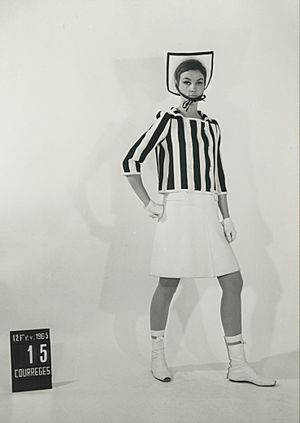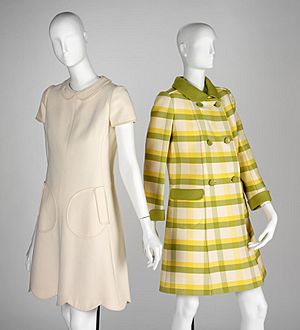André Courrèges facts for kids
Quick facts for kids
André Courrèges
|
|
|---|---|

Courrèges in 1985
|
|
| Born | 9 March 1923 |
| Died | 7 January 2016 (aged 92) Neuilly-sur-Seine, France
|
| Occupation | Fashion designer |
| Known for | Space-age clothes |
|
Label(s)
|
Courrèges |
André Courrèges (9 March 1923 – 7 January 2016) was a French fashion designer. He was famous for his simple and modern designs from the 1960s. His style was inspired by modernism and futurism. He used new technologies and fabrics in his clothes.
Courrèges helped make the go-go boot popular. He is also one of the designers, along with Mary Quant, who is often given credit for inventing the miniskirt.
Contents
Early Life
André Courrèges was born in Pau, a city in the Pyrenees region of France. He wanted to study design at art school. However, his father, who was a butler, wanted him to become an engineer.
Courrèges went to engineering school instead. During World War II, he became a pilot for the French Air Force.
Career in Fashion
In 1945, when he was 25, Courrèges moved to Paris. He first worked at the fashion house of Jeanne Lafaurie. A few months later, he joined the famous designer Cristóbal Balenciaga.
Courrèges worked for Balenciaga for 10 years. He learned a lot about how to cut and build clothes. In 1961, Courrèges started his own fashion company.
He became known for his very simple, geometric, and modern designs. These included the "little white dress" and pants for women. His clothes were often worn with low-heeled white ankle boots. This style became known as the Courrèges boot, which later turned into the popular go-go boot.
Courrèges's autumn 1964 collection changed the fashion world. It featured modern, futuristic designs that were new at the time. This collection included tailored tunics and trousers. It also showed his version of the miniskirt.
He paired his shorter skirts with white or colored leather boots that reached the calf. This look became very important in fashion during the 1960s and was copied by many.
The Miniskirt Debate
There is a debate about who first created the miniskirt. Some say it was Courrèges, and others say it was Mary Quant from London. Courrèges said he invented it. He claimed that Mary Quant only made it popular for everyday people.
Courrèges showed short skirts (four inches above the knee) in January 1965. He had already shown "above-the-knee" skirts in 1964. The New York Times called his August 1964 show the "best show seen so far" that season.
Some experts, like Valerie Steele, say Courrèges was designing short skirts as early as 1961. However, she believes Mary Quant has stronger proof for her claim. Others, like Jess Cartner-Morley, directly credit Courrèges with inventing the miniskirt.
The Independent newspaper also stated that Courrèges was the inventor of the miniskirt, at least in his own view and that of French fashion. The argument was often seen as high fashion versus street fashion, and France versus Britain. There is no final answer either way.
Besides short skirts, Courrèges was famous for his trouser suits. He also designed clothes with cut-out backs and midriffs. These designs were made for a new type of active young woman.
Valerie Steele called Courrèges's work a "brilliant high-fashion version of youth fashion." One of his most famous looks was a knit bodystocking with a gabardine miniskirt worn around the hips. This look was copied a lot, which made him unhappy. He did not hold another press show for his work until 1967.
Materials and Colors
Courrèges liked to use new materials like plastics, such as vinyl. He also used stretchy fabrics like Lycra. He often preferred white and silver colors. But he also added bright splashes of citrus colors.
His August 1964 show featured mostly white designs. These were balanced with touches of his special clear pink, a bright green, different shades of brown, and poppy red.
Business Growth
In 1967, Courrèges married Coqueline Barrière. She was his design assistant. They had met while working at Balenciaga. They worked together as a husband and wife team for the rest of his life.
In 1968, Courrèges sold part of his company to L'Oréal. This helped him grow his business. By 1972, he had 125 stores around the world. That year, Courrèges designed the staff uniforms for the 1972 Summer Olympics in Munich.
He started offering menswear in 1973. He also created perfumes like Empreinte and Eau de Courrèges. In his clothing designs, he stuck to the Space Age styles he created in the 1960s. He did not change his style much, even as fashion changed in the 1970s. By the end of the 1970s, Courrèges signed deals to put his name on many products, from shoes to towels.
In 1983, Courrèges worked with the Japanese car company Honda. He designed special versions of their TACT motor scooter. In 1984, he designed the Peugeot "Courrèges" bicycle. This was a limited edition model in two colors.
By 2005, his wife, Madame Courrèges, took over as the artistic director for the brand. André Courrèges had retired in 1995. In 2011, André and Coqueline Courrèges sold the Courrèges brand to two advertising executives.
Space Age Design
Courrèges's Spring 1964 collection made him known as the "Space Age designer." This collection featured coats with sharp, sculpted shapes. It also had simple, sleeveless or short-sleeved minidresses with special seams. Tunics were worn with low-waisted pants.
A famous look was the straight minidresses with new tailoring. They had cut-out panels that showed the waist, midriff, and back. Courrèges strongly believed in freeing fashion. He said that "A woman's body must be hard and free, not soft and harnessed." This is why his cut-out panel clothes were worn without bras.
Accessories were inspired by astronauts' gear. These included goggles, helmets, and flat boots. White and metallic colors were used to make the collection look futuristic. He used unusual materials like metal, plastic, and PVC. This was very new for high fashion.
The entire collection was celebrated. British Vogue announced that 1964 was "the year of Courrèges." The New York Times called him "the brightest blaze of the year." This showed how his white dresses were replacing the traditional little black dress.
Other designers like Pierre Cardin and Paco Rabanne were also influenced by his "future" fashion looks. As his designs became popular, they were copied by companies that made affordable clothes. This made his style available to many people.
Later Life and Death
André Courrèges suffered from Parkinson's disease for the last 30 years of his life. He passed away on 7 January 2016, at the age of 92. He died in Neuilly-sur-Seine, a town outside Paris. He was survived by his wife, Coqueline, and their daughter.
News of his death was shared widely. Many designers honored his life online. The President of France, François Hollande, posted on Twitter. He said, "A revolutionary designer, André Courrèges made his mark on haute couture using geometric shapes and new materials."
Courrèges was a designer who always looked to the future. He even predicted the idea of healthy living and toned bodies in his 1982 book. Carla Sozzani, who owns a famous store called 10 Corso Como, said that Courrèges "changed the concept of couture, marking the turn of fashion into a new era."
See Also
 In Spanish: André Courrèges para niños
In Spanish: André Courrèges para niños



